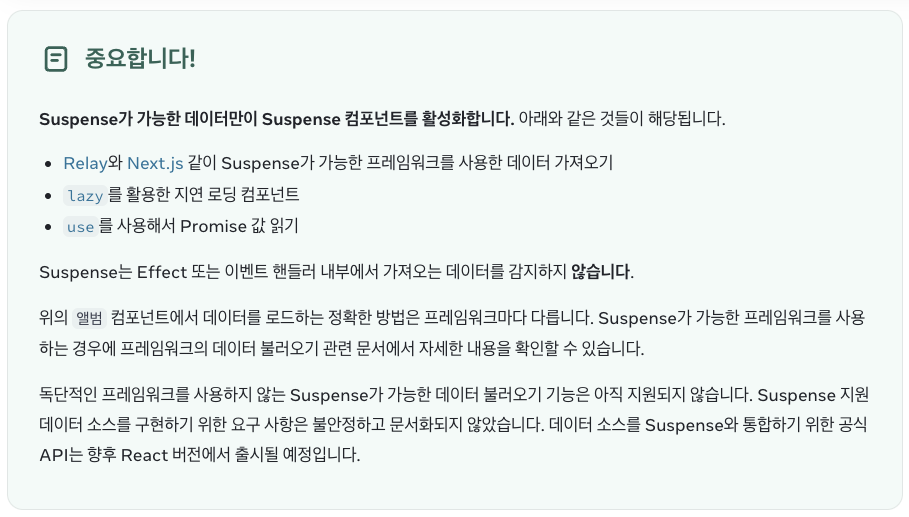미리보는 React 19 신기능 - useFormState
February 24, 20244 minutes
안녕하세요?
오늘은 한참 화두인 React 19의 신기능에 대해 잠깐 살펴보는 시간을 갖도록 하겠습니다.
** 목 차 **
React 19에서 로딩 상태를 관리하지 않아도 됩니다
소개
React 18까지 우리는 비동기 처리를 수행할 때 서버와 통신하거나 다른 비동기 작업을 할 때, 처리 상태를 UI에 표시하기 위해 상태 관리가 필요했었는데요.
하지만 React 19부터는 이러한 상태 관리가 필요 없어져서 코드를 더 깔끔하게 작성할 수 있게 되었습니다.
(여기서 중요한 점은 아쉽게도 React 19는 아직 릴리스되지 않았다는 거죠. 참고만 바랍나다.)
읽기 처리 상태 비교
React 17
React 17까지는 처리 상태를 정의하고, 처리 상황을 반영하는 코드를 아래와 같은 방시으로 작성해야 했습니다.
예를 들어 페이지를 열 때 데이터를 가져와 표시하는 경우 (React 17): 로딩 상태 관리
function Component() {
const [data, setData] = useState(null)
const [loading, setLoading] = useState(false)
useEffect(() => {
setLoading(true)
getAsynchronously().then(res => {
setData(res.data)
setLoading(false)
})
}, [])
return (
<div>
{loading && <p>로딩 중...</p>}
{data && <p>{data}</p>}
</div>
)
}React 18
React 18에서는 Suspense가 등장했습니다.
비동기 읽기 처리 상태를 관리할 필요가 없어졌습니다.
예를 들어 페이지를 열 때 데이터를 가져와 표시하는 경우 (React 18): 로딩 상태 관리가 불필요합니다.
function Component() {
const getPromise = getAsynchronously() return (
<div>
<Suspense fallback={<p>로딩 중...</p>}>
<Data getPromise={getPromise} />
</Suspense>
</div>
)
}
// use는 실험적인 기능이며, React 공식 문서에서는 유사한 기능을 가진 타사 라이브러리 사용을 권장합니다.
// https://ko.react.dev/reference/react/Suspense#usage 참조
function Data({ getPromise }) {
const { data } = use(getPromise)
return <p>{data}</p>
}작성 처리 상태 처리 방법 비교
작성 시에도 마찬가지로 처리 상태를 정의하고, 상태를 반영하는 코드를 작성해야 했습니다.
버튼 클릭 시 데이터 전송 예제 (React 18): pending 관리
function Component() {
const [pending, setPending] = useState(false);
const post = () => {
setPending(true);
postAsynchronously().then(() => {
setPending(false);
});
};
return <button onClick={post}>{pending ? "전송 중..." : "게시"}</button>;
}이제 React 19에서는 form이 등장했습니다.
Suspense와 같은 새로운 기능이 아니라 기존의 form을 약간 개선한 것으로 보이는데요.
버튼 클릭 시 데이터 전송 예제 (React 19): pending 관리 불필요
function Component() {
const post = async () => {
await postAsynchronously();
};
return (
<form action={post}>
<Button />
</form>
);
}
function Button() {
const { pending } = useFormState();
return <button>{pending ? "전송 중..." : "글 작성 완료"}</button>;
}앞으로 React 19에서는 비동기 작업 처리시 상태 관리가 더 이상 필요하지 않을거 같네요.
예를 들어 글을 작성하는 form이 경우, form 내부의 컴포넌트에서 useFormState를 사용하여 글 작성 상태를 가져오고, 글 작성 중인 UI(“전송 중”)와 글 작성 후의 UI(“글 작성 완료”)만 선언하면 됩니다.
이제 React 19가 도입되면, 비동기적인 읽기와 쓰기도 깔끔하게 표현할 수 있어 정말 좋아질 거 같네요.
전체적인 데모 코드도 같이 살펴볼까요?
<!doctype html>
<html lang="en">
<head>
<meta charset="UTF-8" />
<meta name="viewport" content="width=device-width, initial-scale=1.0" />
<title>React canary</title>
<script type="importmap">
{
"imports": {
"@jsxImportSource": "https://esm.sh/react@18.3.0-canary-a9cc32511-20240215",
"react": "https://esm.sh/react@18.3.0-canary-a9cc32511-20240215",
"react-dom": "https://esm.sh/react-dom@18.3.0-canary-a9cc32511-20240215",
"react-dom/client": "https://esm.sh/react-dom@18.3.0-canary-a9cc32511-20240215/client"
}
}
</script>
<script type="module" src="https://esm.sh/run" defer></script>
</head>
<body>
<div id="root"></div>
<script type="text/babel">
import { createRoot } from "react-dom/client";
import { use, Suspense, useState, useEffect, useRef } from "react";
import { useFormStatus } from "react-dom";
function React17Get() {
const [data, setData] = useState(null);
const [loading, setLoading] = useState(false);
useEffect(() => {
setLoading(true);
getAsynchronously().then((res) => {
setData(res.data);
setLoading(false);
});
}, []);
return (
<div>
{loading && <p>loading...</p>}
{data && <p>{data}</p>}
</div>
);
}
function React18() {
const getPromise = getAsynchronously();
return (
<div>
<Suspense fallback={<p>loading...</p>}>
<Data getPromise={getPromise} />
</Suspense>
</div>
);
}
function Data({ getPromise }) {
const { data } = use(getPromise);
return <p>{data}</p>;
}
function React17Post() {
const [pending, setPending] = useState(false);
const post = () => {
setPending(true);
postAsynchronously().then(() => {
setPending(false);
});
};
return (
<button onClick={post}>{pending ? "sending..." : "post"}</button>
);
}
function React19() {
const post = async () => {
await postAsynchronously();
};
return (
<form action={post}>
<Button />
</form>
);
}
function Button() {
const { pending } = useFormStatus();
return <button>{pending ? "sending..." : "post"}</button>;
}
function App() {
return (
<>
<React17Get />
<React18 />
<React17Post />
<React19 />
</>
);
}
const root = createRoot(document.querySelector("#root"));
root.render(<App />);
async function getAsynchronously() {
await new Promise((resolve) => setTimeout(resolve, 1000));
return { data: "hello world" };
}
async function postAsynchronously() {
await new Promise((resolve) => setTimeout(resolve, 1000));
return { data: "hello world" };
}
</script>
</body>
</html>